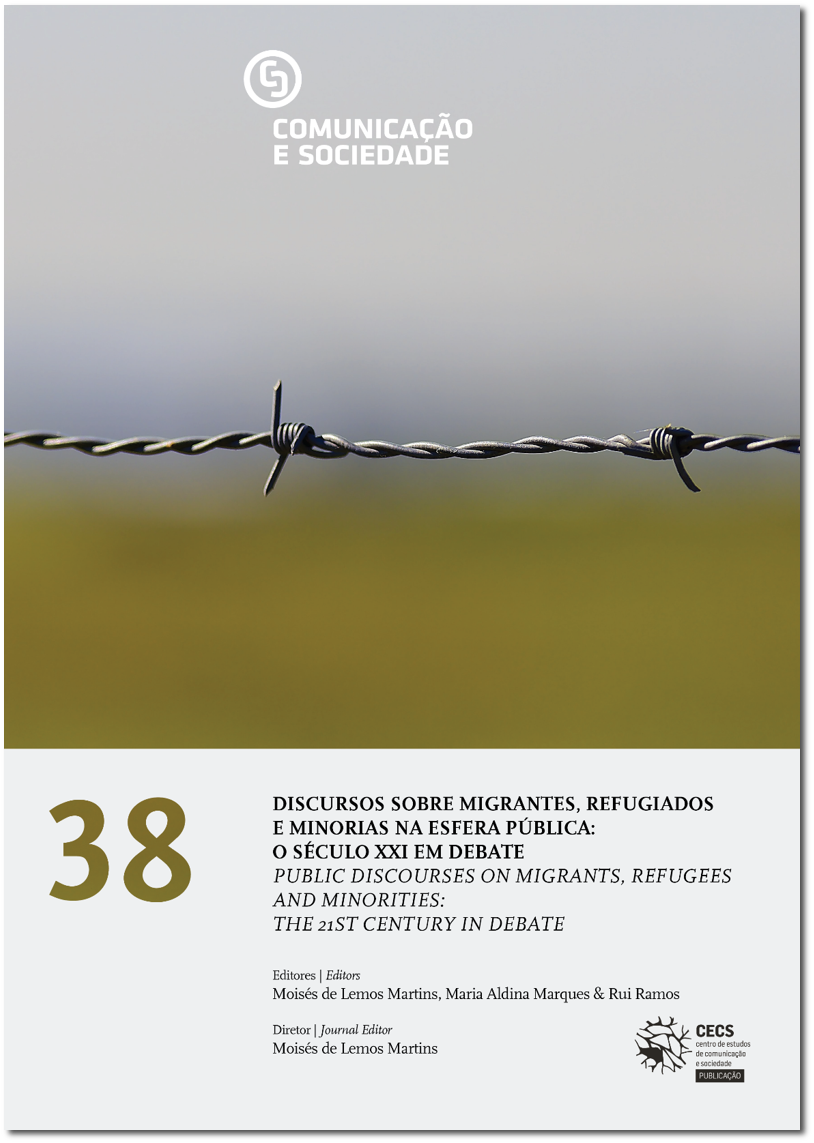Images and power: scenario, erasure and painting
DOI:
https://doi.org/10.17231/comsoc.38(2020).2451Keywords:
photography, painting, power, nazism, stalinismAbstract
This article addresses the power of images in three periods of 20th century history. The use of images, particularly of photography, during these periods became omnipresent, although there are many other examples of the power of images over the relevance of words: the sight of Phryne’s partially naked body, for instance, had a big impact in her trial in the 4th century. Two of the examples presented in this paper (Nazism and Stalinism) used images as an instrument of power. They aimed to present simultaneously a sense of heroism and of “normalization” in radical contrast to the brutality that left a decisive mark in history as one of the most tragic dark moments of the 20th century. On the other hand, under Stalin, photos and images were manipulated: erasing people in photos can be understood as a macabre allegory of their annihilation in real life. The efficacy in the re-construction of reality through the manipulation of photos seems to result from an illusional omnipotence, as if dictators had the power to enunciate, create and destroy “reality”. The third part of this article discusses the answer open and given by painting to the increasing erosion of images witnessed nowadays. Painting, contrary to the ephemeral nature of photography, survive dark times. It resists in a stubborn way, as we can see, for instance in the example of Tuymans’ paintings. You cannot erase its memory. Painting is not “programmatic”. It is an attempt to depollute images. And by doing this, it tears open a space for the search for meaning.
Downloads
References
Barthes, R. (1976). Mitologias. Lisboa: Edições 70.
Benjamin, W. (2006). A modernidade, obras escolhidas de Walter Benjamin. Lisboa: Assírio & Alvim.
Blackmore, E. (2019, 26 de abril). How photos became a weapon in Stalin’s Great Purge. Canal História. Retirado de https://www.history.com/news/josef-stalin-great-purge-photo-retouching
Bauman, Z. & Bordini, C. (2016). Estado de crise. Lisboa: Relógio d´Água.
Bougeois, C. (2019). Luc Tuymans. La Pelle. Veneza: Marsilio Editori. Retirado de https://www.palazzograssi.it/site/assets/files/7599/guidina_la_pelle_tuymans_fra.pdf
Brett, D. W. (2016). Banality, memory and the index: Thomas Demand and Hitler’s photographer. Journal photographies, 9, 233-249.
Cooper, C. (1995). Hyperides and the trial of Phryne. Phoenix, 49(4), 303-318.
Cowling, E. (2009). Competition and collaboration: Picasso and the old masters. In C. Riopelle & A. Robbins, Catálogo Picasso: challenging the past (pp. 11-23). Londres: The National Gallery.
Crespo, N. (2019, 20 de agosto). Luc Tuymans: a persistência política da pintura. Público - Ípsilon, pp. 24-25.
Curado, A. L. (2008). Mulheres em Atenas. Lisboa: Sá da Costa Editora.
Danto, A. C. (1964). The artworld. The Journal of Philosophy, 61(19), 571-584.
Debord, G. (2018). La société du spectacle. Paris: Gallimard.
Dickerman, L. (2000). Camera obscura: socialist realism in the shadow of photography. The MIT Press, 93, 138-153.
D’ Orey, C. (2007). O que é a Arte? A perspectiva analítica. Lisboa: Dinalivro.
Duchamp, M. (1990). O engenheiro do tempo perdido, entrevistas com Pierre Cabanne. Lisboa: Assírio & Alvim.
Dyck, A. R. (2001). Dressing to kill: attire as a proof and means of characterization in Cicero’s speeches. Arethusa, 34(1), 119-130. Retirado de http://www.jstor.org/stable/779160
Eco, U. (2004). Os limites da interpretação. Lisboa: Difel.
Fellini, F. (Realizador). (1963). 8 ½ [Filme]. Roma: CSC – Cineteca Nazionale.
Freund, G. (1995). Fotografia e sociedade. Lisboa: Vega.
Gayford, M., Holborn, M. & Dawson, D. (2018). Lucian Freud. Londres, Nova Iorque: Phaidon Press.
Gessen, M. (2018, 15 de julho). The photo book that captured how the soviet regime made the truth disappear. The New Yorker. Retirado de https://www.newyorker.com/culture/photo-booth/the-photo-book-that-captured-how-the-soviet-regime-made-the-truth-disappear
Górgias. (1993). Testemunhos e fragmentos. Lisboa: Colibri.
Gortemaker, H. B. (2012). Eva Braun: life with Hitler. Londres: Vintage.
Harrison, M. & Daniels, R. (2016). Francis Bacon: catalogue raisonné. Londres: Estate of Francis Bacon.
Hoffmann, H. (1932). Hitler wie ihn keiner kennt. Berlin: Verlag und Vertriebs-Gesellschaft M. B. H.
Júnior, M. A. (2008). Eficácia retórica: a palavra e a imagem. Revista Rhêtorikê. Retirado de http://www.rhetorike.ubi.pt/00/pdf/alexandre-junior-eficacia-retorica.pdf
Kapparis, K. (2017). Prostitution in the ancient greek world. Berlim: De Gruyter.
Kloska, J. (Realizador). (2014) The rise of the Nazi Party [Documentário]. Athena.
Kruszynski, A., Bezzola, T. & Lingwood, J. (2010). Thomas Struth: photographs 1978−2010. Nova Iorque: The Monacelli Press.
Milhazes, J. (2018). Laurenti Béria. O carrasco ao serviço de Estaline. Lisboa: Oficina do Livro.
Montefiore, S. S. (2017). Estaline. A corte do Czar vermelho. Lisboa: Alêtheia Editores.
Moorhouse, R. (2014). Calling time on Hitler’s Hoax. History Today, 64(12), 7.
Overy, R. (2016). Os ditadores. A Alemanha de Hitler e a Rússia de Estaline. Lisboa: Bertrand Editora.
Pereira, M. H. R. (1971). Helade, antologia da cultura grega. Coimbra: Faculdade de Letras da Universidade de Coimbra.
Pina, L. (1984). John Ford – a luz e o olhar. In Catálogo John Ford. Lisboa: Cinemateca Portuguesa/Fundação Calouste Gulbenkian.
Pisch, A. (2016). The personality cult of Stalin in Soviet posters, 1929 - 1953: archetypes, inventions and fabrications. ANU Press. Retirado de http://press- files.anu.edu.au/downloads/press/n2129/html/cover.xhtml?referer=2129&page=0#
Reust, H. R. (2006). Penumbra – Um turno da noite. In Catálogo Dusk/Penumbra. Porto: Museu de Arte Contemporânea de Serralves.
Rosenbaum, R. (2012, 03 de setembro). Hitler’s doomed angel. Vanity Fair. Retirado de https://www.vanityfair.com/news/1992/04/hitlers-doomed-angel
Siegal, N. (2019, 21 de março). Luc Tuymans, master of moral complexities, tries something new. The New York Times. Retirado de https://www.nytimes.com/2019/03/21/arts/design/luc-tuymans-palazzo-grassi-mosaic-la-pelle.html.
Sullivan, R. (2016). A filha de Estaline. A vida extraordinária e tumultuosa de Svetlana Alliluyeeva. Lisboa: Temas e Debates/Círculo dos Leitores.
Tuymans, L. (2006). Sobre a imagem. In Catálogo Dusk/Penumbra. Porto: Museu de Arte Contemporânea de Serralves.
Zelizer, B. (2010). How news images move the public. USA: Oxford University Press.
Zelizer. B. (2018). Crise, incerteza e jornalismo. Electra, 4, 89-106.
Downloads
Published
How to Cite
Issue
Section
License
Copyright (c) 2020 Comunicação e Sociedade

This work is licensed under a Creative Commons Attribution-NonCommercial 4.0 International License.
Authors own the copyright, providing the journal with the right of first publication. The work is licensed under a Creative Commons Attribution 4.0 International License.












